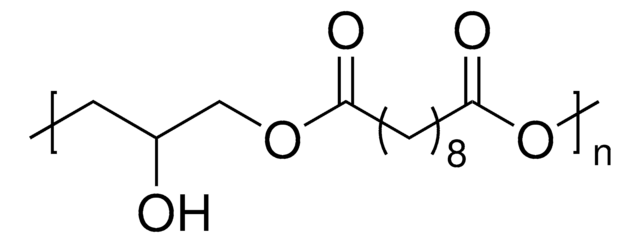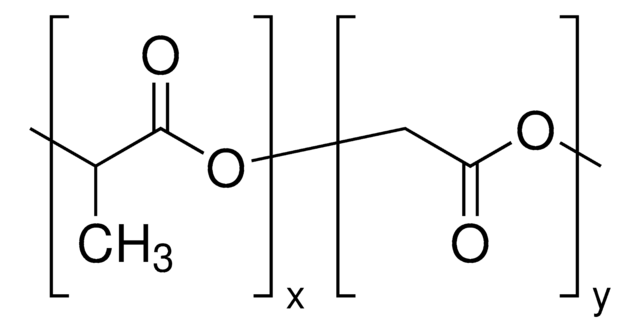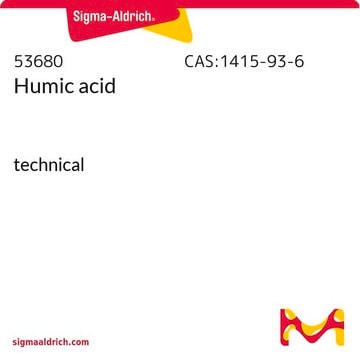900210
Regenerez® Poly(glycerol sebacate) Resin
Synonyme(s) :
PGS, Poly(glycerol sebacic acid)
Se connecterpour consulter vos tarifs contractuels et ceux de votre entreprise/organisme
About This Item
Formule linéaire :
(C13H22O5)n
Code UNSPSC :
12352200
Produits recommandés
Forme
paste
Niveau de qualité
Température de transition
flash point >230 °F
Température de stockage
−20°C
Application
Regenerez® Poly(glycerol sebacate) is a bioresorbable elastomer. The physical properties can be tuned from an elastomer to a thermoset(U.S. Patent No. 9.359,472) by curing PGS to the desired level of cross-linking. The inherent elastomeric properties of PGS can be used in a variety of applications in regenerative medicine and tissue engineering.
Caractéristiques et avantages
- Bioresorbable.
- Comprised of naturally occurring metabolites (glycerol and sebacic acid).
- Tunable mechanical properties.
- Versatile platform for further modification.
- Closely simulates modulus of human tissue.
- Enables healing without harmful immune response.
Informations légales
U.S. Patent No. 9,359,472.
Regenerez is a registered trademark of The Secant Group, LLC
Code de la classe de stockage
11 - Combustible Solids
Classe de danger pour l'eau (WGK)
WGK 3
Point d'éclair (°F)
No data available
Point d'éclair (°C)
No data available
Certificats d'analyse (COA)
Recherchez un Certificats d'analyse (COA) en saisissant le numéro de lot du produit. Les numéros de lot figurent sur l'étiquette du produit après les mots "Lot" ou "Batch".
Déjà en possession de ce produit ?
Retrouvez la documentation relative aux produits que vous avez récemment achetés dans la Bibliothèque de documents.
Les clients ont également consulté
Coral Salvo-Comino et al.
Sensors (Basel, Switzerland), 21(3) (2021-02-13)
The integration of nanomaterials as electron mediators in electrochemical biosensors is taking on an essential role. Due to their high surface-to-volume ratio and high conductivity, metallic nanowires are an interesting option. In this paper, silver nanowires (AgNWs) were exploited to
Cathryn A Sundback et al.
Biomaterials, 26(27), 5454-5464 (2005-04-30)
No satisfactory method currently exists for bridging neural defects. Autografts lead to inadequate functional recovery, and most available artificial neural conduits possess unfavorable swelling and pro-inflammatory characteristics. This study examined the biocompatibility of a novel biodegradable elastomer, poly(glycerol sebacate) (PGS)
Wei Wu et al.
Nature medicine, 18(7), 1148-1153 (2012-06-26)
Host remodeling is important for the success of medical implants, including vascular substitutes. Synthetic and tissue-engineered grafts have yet to show clinical effectiveness in arteries smaller than 5 mm in diameter. We designed cell-free biodegradable elastomeric grafts that degrade rapidly
Samer H Zaky et al.
Biomedical materials (Bristol, England), 9(2), 025003-025003 (2014-02-04)
For bone engineering, the optimal scaffolding material and composition has yet to be elucidated. In this study, we investigated poly (glycerol sebacate) (PGS), an elastomer known primarily for its soft tissue regeneration ability, as a suitable substrate to support osteo-precursor
Howard I Pryor et al.
Surgery, 146(3), 490-497 (2009-09-01)
The objectives of this study were to evaluate the efficacy of poly(glycerol) sebacate (PGS) films for the prevention of visceroparietal peritoneal (VP) adhesions and demonstrate the ease of laparoscopic PGS film placement. Peritoneal adhesions occur in nearly 95% of all
Notre équipe de scientifiques dispose d'une expérience dans tous les secteurs de la recherche, notamment en sciences de la vie, science des matériaux, synthèse chimique, chromatographie, analyse et dans de nombreux autres domaines..
Contacter notre Service technique











